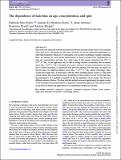Por favor, use este identificador para citar o enlazar a este item:
http://hdl.handle.net/10261/192265COMPARTIR / EXPORTAR:
 SHARE SHARE
 CORE
BASE CORE
BASE
|
|
| Visualizar otros formatos: MARC | Dublin Core | RDF | ORE | MODS | METS | DIDL | DATACITE | |

| Título: | The dependence of halo bias on age, concentration and spin |
Autor: | Sato-Polito, G.; Montero-Dorta, Antonio D. CSIC ORCID; Abramo, L. R.; Prada, Francisco CSIC ORCID ; Klypin, Anatoly | Palabras clave: | Cosmology: theory Dark matter Galaxies: formation Galaxies: haloes Large-scale structure of the universe Methods: numerical |
Fecha de publicación: | 2019 | Editor: | Oxford University Press | Citación: | Monthly Notices of the Royal Astronomical Society 487(2): 1570-1579 (2019) | Resumen: | Halo bias is themain link between thematter distribution and darkmatter haloes. In its simplest form, halo bias is determined by halo mass, but there are known additional dependencies on other halo properties which are of consequence for accurate modelling of galaxy clustering. Here, we present the most precise measurement of these secondary-bias dependencies on halo age, concentration, and spin, for a wide range of halo masses spanning from 1010.7 to 1014.7 h-1 M⊙. At the high-mass end, we find no strong evidence of assembly bias for masses above Mvir ~1014 h-1 M⊙. Secondary bias exists, however, for halo concentration and spin, up to cluster-size haloes, in agreement with previous findings. For halo spin, we report, for the first time, two different regimes: above Mvir ~ 1011.5 h-1 M⊙, haloes with larger values of spin have larger bias, at fixed mass, with the effect reaching almost a factor 2. This trend reverses below this characteristic mass. In addition to these results, we test, for the first time, the performance of a multitracer method for the determination of the relative bias between different subsets of haloes.We show that this method increases significantly the signal to noise of the secondary-bias measurement as compared to a traditional approach. This analysis serves as the basis for follow-up applications of our multitracer method to real data. © 2019 The Author(s) Published by Oxford University Press on behalf of the Royal Astronomical Society. | Versión del editor: | http://dx.doi.org/10.1093/mnras/stz1338 | URI: | http://hdl.handle.net/10261/192265 | DOI: | 10.1093/mnras/stz1338 | ISSN: | 0035-8711 |
| Aparece en las colecciones: | (IAA) Artículos |
Ficheros en este ítem:
| Fichero | Descripción | Tamaño | Formato | |
|---|---|---|---|---|
| IAA_2019_stz1338.pdf | 689,1 kB | Adobe PDF |  Visualizar/Abrir |
CORE Recommender
SCOPUSTM
Citations
26
checked on 21-abr-2024
WEB OF SCIENCETM
Citations
24
checked on 22-feb-2024
Page view(s)
173
checked on 24-abr-2024
Download(s)
183
checked on 24-abr-2024
Google ScholarTM
Check
Altmetric
Altmetric
NOTA: Los ítems de Digital.CSIC están protegidos por copyright, con todos los derechos reservados, a menos que se indique lo contrario.
